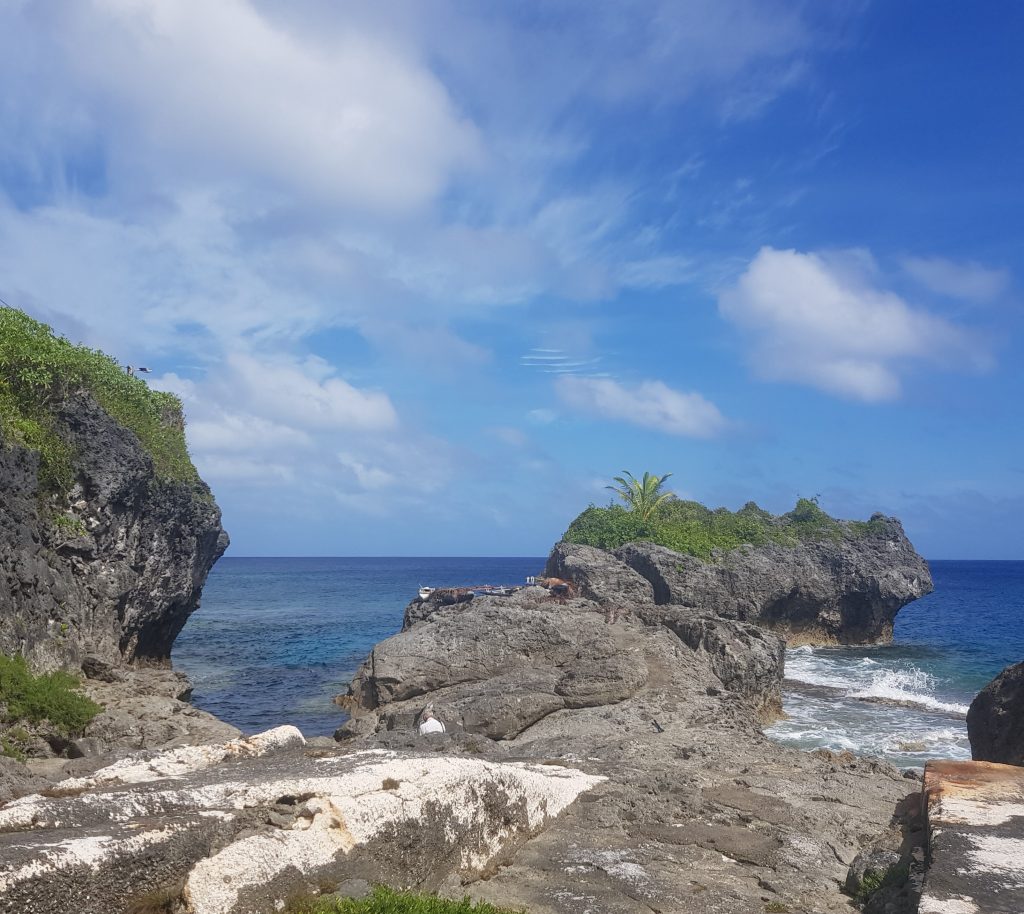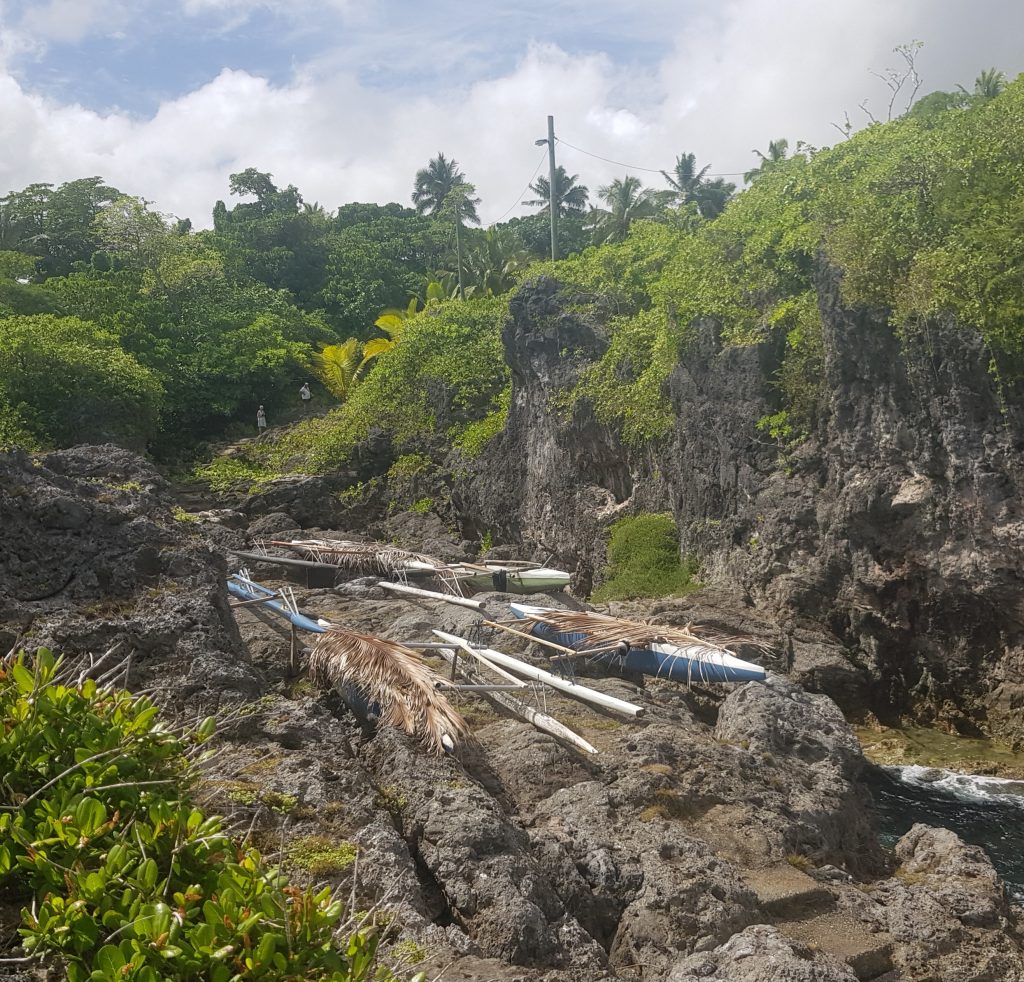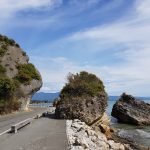I’ve now recounted several of my adventures on Niue. You’ve seen me settle in, meet the people, snorkel and sightsee. But I’m not the sort of tourist who can just leave it at that. I need to dig in a little, learn the history, and find out just how this little island in the middle of the Pacific came to be associated with New Zealand.
To do that, we need to go back to the first meetings between Niue and the representatives of Empire, as the people of the Pacific were slowly but irresistibly drawn into the web of interconnections spreading across the globe.
It started with a man both celebrated and reviled in our own New Zealand.
Captain James Cook was well into his second voyage in search of the great southern land, Terra Australis, and heading back south after wintering in the tropics, when the moment of first meeting occurred.
The sea track to Opaahi, is within easy walk of central Alofi. A sign at the entrance warns visitors in no uncertain terms not to touch the vaka (traditional canoes) which are kept here, to which – as a most well behaved and considerate tourist – I took mild offence. Beyond the sign concrete steps lead me to a gnarled finger of limestone projecting out into the ocean.

It was on the afternoon of 20 June 1774 that Captain Cook’s watch men first espied “a tableland of good extent” in the western distance. The next morning they drew close to the object, approaching from the north, and searched the unforgiving cliffs for somewhere to land.
The first Europeans to set foot on Niue did so somewhere to the north, landing in the ship’s boat. Once ashore they performed the “ceremony of taking possession” and proceeded to explore. It was not long however before they were confronted by a small group of people who could be forgiven for thinking that the island was already in their possession, as evidenced by the fact that they lived there.
Though Cook’s crew attempted to make friendly gestures, one of the Niueans hurled a throwing stone which hit one of the crew on the arm. Two shots were fired and the Niueans fled. The explorers hung around for a while to see if anyone would come back but, perhaps unsurprisingly, nobody did.
So they returned to the Resolution and continued southward, rounding Makapu Point and entering Alofi Bay. A few brave souls took boats out to search the crags for a landing and one or two even made it ashore, but they beat a hasty retreat in fear that that the island’s residents were approaching.
So Opaahi was the third place that Cook’s men attempted to come ashore and make contact, having spotted four vaka on the beach here. Upon landing, Cook and four others immediately set about investigating the vaka and their contents, and also placed a few gifts in each.
So it turns out the first thing the very first tourists to Niue did upon arrival was to interfere with the vaka. No wonder they don’t trust us to keep our hands to ourselves.

At that moment, a group of about 30 Niue Islanders emerged from the interior brandishing weapons and performing war dances and chants. Two spears were thrown and the explorers responded with musket fire, although it seems nobody was seriously hurt. Both sides eventually decided to retreat and Cook decided there and then to depart Niue entirely, noting in his journal that “the conduct and aspect of these islanders occasioned me naming it Savage Island”.
Unlike Tasman’s first encounter with the Māori, we actually do have another side to the story. First of all, a good vaka might take a Niuean family up to a year to complete, making it a precious possession indeed. These days, thanks to modern power tools, the construction window has been reduced to a mere three months.
Secondly, the Niueans had ample reason to be wary of visitors, having every so often been the targets of invasion from neighbouring islands, one such instance introducing a disease that had awful effects upon the residents.
Tradition also holds that the incident at Opaahi was in fact a traditional greeting that had been misinterpreted by Cook and his companions as an attack. Usually on his voyages Cook brought along a native Pacific Islander to provide advice and translation services, but on this occasion he was not carrying any, as he didn’t expect to be able to drop them back off before returning to England. Captain Cook is not renowned for his cultural sensitivity, and it’s possible that the lack of coaching in this case contributed to the incident.

The episode, while alarming, didn’t have much of an immediate effect on Niue. The various villages tended to keep separate so some sections of the population may not have even been aware that strangers had come to the island.
Nor was it particularly exciting to the Europeans. Cook passed the island on his third Pacific voyage in 1777, but didn’t attempt any further contact. Niue, as “Savage Island”, was now on the map, but the apparent hostility of the people and lack of anywhere decent to land served to keep the island isolated. So at the cost of being labelled as totally unreasonable the Niueans were left to themselves for another 50 years.
The next recorded interaction between Europeans and the people of Niue came in the age of whaling. In 1828 it was reported in the Sydney Gazette that an unnamed American trader had attempted to trade, but that two members of the crew attempting to come ashore were seized and killed. Captain Hindson of the Lord Rodney was the one to relay this story, and he only learned it after calling at Niue himself. Luckily he fared slightly better, and succeeded in conducting some trade at gunpoint after some preliminary shows of force from both sides. Since the Niueans possessed no metal implements Hindson concluded that they (and the other less lucky whalers) were probably the first to visit since Cook himself.
After this shaky start the Niueans quickly caught on, and soon were eager to establish trade with passing vessels. The most prized item was the fish hook, seeing as the island lacked any hard rock or supplies of bone to produce its own. In return, fresh food was offered. Usually these transactions occurred offshore, with the Niueans paddling out to the visiting whalers in their vaka.

After a rocky start a stable and mutually beneficial relationship had developed, as long as the visitors didn’t press their luck and the Niueans were honest with their trades. But change was once again on the horizon, as the whaling era drew to a close, and European religion began to send its disciples out into the Pacific in search of souls to save.
Niue would not be able to maintain its aggressive style of independence forever.
References:
NIUE 1774-1974, 200 years of contact and change by Margaret Pointer
“Kua Liu Mai Au” I have Returned by Taoga Niue, Government of Niue
Niuē-fekai (or Savage) Island and its People by S. Percy Smith




This reminds me so much of my childhood. We used to go to the sea before, since our house is near to the sea. And our neighbor has motor boat just like the one on the photo.
https://www.aucklandpestcontrolnz.kiwi/